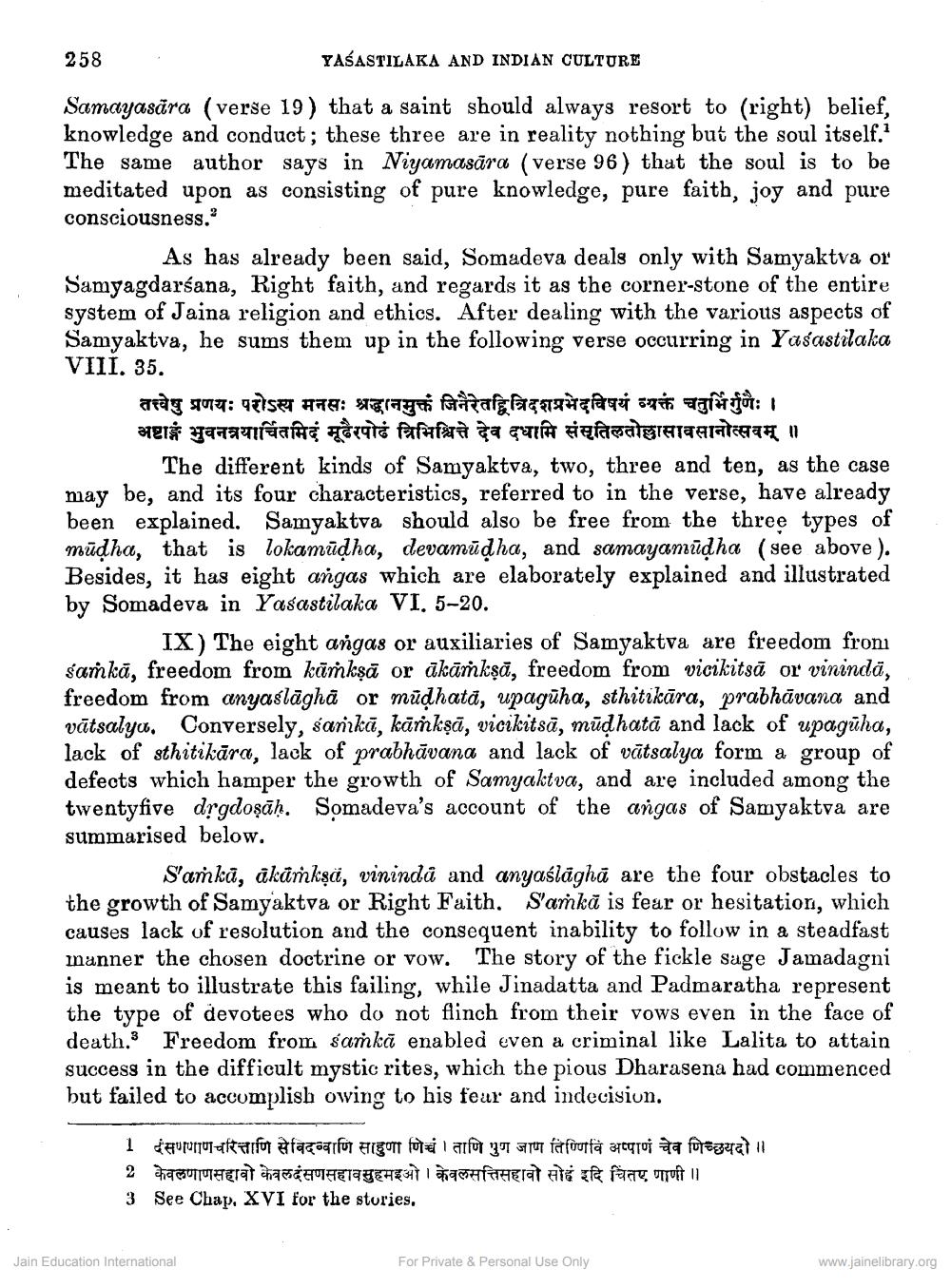________________
258
YASASTILAKA AND INDIAN CULTURE
Samayasära (verse 19 ) that a saint should always resort to (right) belief, knowledge and conduct; these three are in reality nothing but the soul itself. The same author says in Niyamasāra (verse 96 that the soul is to be meditated upon as consisting of pure knowledge, pure faith, joy and pure consciousness.
As has already been said, Somadeva deals only with Samyaktva or Samyagdarśana, Right faith, and regards it as the corner-stone of the entire system of Jaina religion and ethics. After dealing with the various aspects of Samyaktva, he sums them up in the following verse occurring in Yasastilaka VIII. 35.
तत्त्वेषु प्रणयः परोऽस्य मनसः श्रद्धानमुक्तं जिनैरेतद्वित्रिदशप्रभेदविषयं व्यक्तं चतुर्भिर्गुणैः । अष्टाङ्गं भुवनत्रयार्चितमिदं मूढरपोढं त्रिभिश्चित्ते देव दधामि संसृतिलतोल्लासावसानोत्सवम् ॥
The different kinds of Samyaktva, two, three and ten, as the case may be, and its four characteristics, referred to in the verse, have already been explained. Samyaktva should also be free from the three types of mūdha, that is lokamūdha, devamūdha, and samayanūdha (see above ). Besides, it has eight angas which are elaborately explained and illustrated by Somadeva in Yasastilaka VI. 5-20.
IX) The eight angas or auxiliaries of Samyaktva are freedom from samkā, freedom from kāṁkşā or ākāṁkşā, freedom from vicikitsā or vinindā, freedom from anyaslāghā or müdhată, upagūha, sthitikūra, prabhāvana and vātsalyu. Conversely, sankā, kāṁkşā, vicikitsā, mūdhatā and lack of upagūha, lack of sthitikāra, lack of prabhāvana and lack of vātsalya form a group of defects which hamper the growth of Samyaktva, and are included among the twentyfive drgdoşāḥ. Somadeva's account of the angas of Samyaktva are summarised below.
Samkā, ākāṁksä, vinindů and anyasläghū are the four obstacles to the growth of Samyaktva or Right Faith. Samkā is fear or hesitation, which causes lack of resolution and the consequent inability to follow in a steadfast manner the chosen doctrine or vow. The story of the fickle sage Jamadagni is meant to illustrate this failing, while Jinadatta and Padmaratha represent the type of devotees who do not flinch from their vows even in the face of death. Freedom from sarkā enabled even a criminal like Lalita to attain success in the difficult mystic rites, which the pious Dharasena had commenced but failed to accomplish owing to his fear and indecision.
1 दसणणाणचरित्ताणि सेविदन्वाणि साहुणा णिच्चं । ताणि गुण जाण तिण्णिवि अप्पाणं चेव णिच्छयदो। 2 केवलणाणसहावो केवलदसणसहावसुहमइओ । केवलसत्तिसहावो सोहं इदि चिंतए णाणी ।। 3 See Chap, XVI for the stories,
Jain Education International
For Private & Personal Use Only
www.jainelibrary.org




